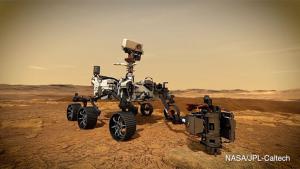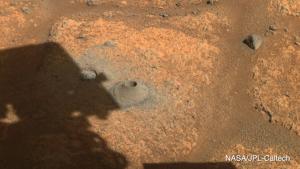Video News Release: UH Mars rover team helps acquire samples of Red Planet
University of Hawaiʻi at MānoaResearcher, Hawaii Institute of Geophysics and Planetology
Eleni Ravanis, 626-922-2810
PhD student, Hawaii Institute of Geophysics and Planetology
Link to video and sound (details below): https://bit.ly/3D5spfX
WHAT: University of Hawaiʻi at Mānoa scientists are currently exploring Mars via a car-sized robot known as the Mars 2020 Perseverance rover. Perseverance is the most sophisticated rover NASA has ever sent to the Red Planet, and the Mars 2020 team are helping acquire samples of rocks from its landing site, the floor of Jezero Crater, for return to Earth by a future mission.
WHO: Sarah Fagents, a researcher at UH Mānoa’s Hawaiʻi Institute of Geophysics and Planetology, and volcanologist with the Mastcam-Z camera team, and Eleni Ravanis, a HIGP PhD student and also a member of the Mastcam-Z team.
WHERE: University of Hawaiʻi at Mānoa
HOW: Using scientific instruments, UH scientists will collect carefully selected rock and sediment samples for possible return to Earth by a future mission. Returning a sample of a lava flow or ash deposit would allow researchers to date the sample and determine an age for those deposits, which in turn allows them to more accurately date other surfaces on Mars, through a technique known as crater chronology.
WHY: After collecting samples and characterizing the lithology (the types of rocks) of the crater’s floor, Perseverance will head West to investigate the deposits of an ancient river delta, which formed early in Mars’ history when the crater contained a lake.
OTHER FACTS:
-
The team has been using a newly enhanced auto navigation system, which allows the rover to drive on its own. Auto navigation makes 3D maps of the terrain ahead, identifies hazards and plans a route around any obstacles without additional direction from controllers back on Earth.
-
After landing on Mars in February, the first 100 Martian sols were devoted to instrument checkouts, helicopter operations and initial science observations. The rover traveled short distances to test drive and instrument capabilities, drop off shields and covers, and deploy the helicopter for its historic flights.
-
This mission is the first stage of an international, multi-agency, decade-plus long program to bring samples from Mars back to Earth. Involvement in missions like Mars 2020 enhances the reputation of UH as an R1 research university, which continues to conduct cutting-edge research at the forefront of space exploration.
VIDEO BROLL: (2 minutes)
0:00-0:50 - photos and video of Perseverance on Mars
0:50-1:49 - overview of the mission of Perseverance on Mars with animation
1:49-2:00 - making of sample tubes for the mission
SOUNDBITES:
Sarah Fagents, Hawaiʻi Institute of Geophysics and Planetology, researcher (18 seconds)
“When we’ve finished in this particular area, we’re going to head over to the delta front. And those deposits were laid down in a lake environment and they might be the location of some of the best potential biosignatures, which is the key driver of this mission, to seek out the signs of [ancient] life.”
Eleni Ravanis, Hawaiʻi Institute of Geophysics and Planetology, graduate student (14 seconds)
“It’s so exciting to be able to see, for the first time, places that we’ve only seen from orbit before. So these are places that we’ve never seen close up, no one has seen close up before. So it’s always really exciting to get these images back and share it with the team.”
Ravanis (13 seconds)
“The auto navigation on the rover means that we can drive farther in a single sol, which is a martian day, which is really useful for this mission because we’re on a tight schedule to explore as much of the crater as we can.”
Photo captions and credit:
Photo 1: The robotic arm on NASA's Perseverance rover reached out to examine rocks in an area on Mars. (Photo credit: NASA/JPL-Caltech)
Photo 2: llustration depicts NASA's Perseverance rover operating on Mars. (Photo credit: NASA/JPL-Caltech)
Photo 3: Perseverance's drill hole for first sample collection attempt. (Photo credit: NASA/JPL-Caltech)




